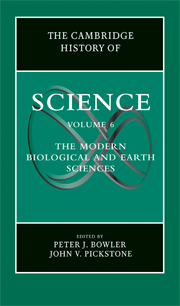Book contents
- Frontmatter
- 1 Introduction
- PART I WORKERS AND PLACES
- PART II ANALYSIS AND EXPERIMENTATION
- PART III NEW OBJECTS AND IDEAS
- 20 Plate Tectonics
- 21 Geophysics and Geochemistry
- 22 Mathematical Models
- 23 Genes
- 24 Ecosystems
- 25 Immunology
- 26 Cancer
- 27 The Brain and the Behavioral Sciences
- 28 History of Biotechnology
- PART IV SCIENCE AND CULTURE
- Index
- References
24 - Ecosystems
from PART III - NEW OBJECTS AND IDEAS
Published online by Cambridge University Press: 28 November 2009
- Frontmatter
- 1 Introduction
- PART I WORKERS AND PLACES
- PART II ANALYSIS AND EXPERIMENTATION
- PART III NEW OBJECTS AND IDEAS
- 20 Plate Tectonics
- 21 Geophysics and Geochemistry
- 22 Mathematical Models
- 23 Genes
- 24 Ecosystems
- 25 Immunology
- 26 Cancer
- 27 The Brain and the Behavioral Sciences
- 28 History of Biotechnology
- PART IV SCIENCE AND CULTURE
- Index
- References
Summary
The word “ecosystem” (from the Greek oïkos, meaning “house” or “habitat,” and sustêma, meaning “set”) was coined in 1935 by the British plant ecologist Arthur George Tansley (1871–1955):
[T]he more fundamental conception is, as it seems to me, the whole system (in the sense of physics), including not only the organism-complex, but also the whole complex of physical factors forming what we call the environment of the biome – the habitat factors in the widest sense. … These ecosystems, as we may call them, are of the most various kinds and sizes.
This definition synthesized three main features of scientific ecology during the interwar years: This new branch of biology was to be devoted to the study of the relations between biotic (i.e., plant and animal) communities and their environment, the ontological status of these communities was still debated, and the question of the true nature of their interdependence with purely physical factors, such as solar energy, was gradually coming to the forefront. The fact that Tansley’s concept was not even mentioned in J. R. Carpenter’s famous ecological glossary (1938), which contains one of the earliest historical surveys of scientific ecology, suggests that this novelty went largely unnoticed before the Second World War. In the 1940s, however, the young North American limnologist Raymond Laurel Lindeman (1916–1942) developed an innovative ecosystems theory close to the presently accepted paradigm.
Information
- Type
- Chapter
- Information
- The Cambridge History of Science , pp. 451 - 466Publisher: Cambridge University PressPrint publication year: 2009
References
Accessibility standard: Unknown
Why this information is here
This section outlines the accessibility features of this content - including support for screen readers, full keyboard navigation and high-contrast display options. This may not be relevant for you.Accessibility Information
- 1
- Cited by
